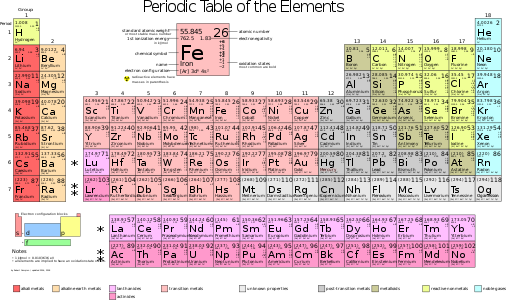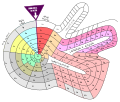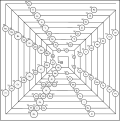Periodic table
This article does not have any sources. (August 2023) |
The periodic table is a table that puts all known chemical elements in a specific order. Elements that have similar characteristics are often put near each other. In the table, the elements are placed in the order of their atomic numbers starting with the lowest number of one, hydrogen. The atomic number of an element is the same as the number of protons in that particular nucleus of an atom. In the table the elements are arranged into periods and group. A row of elements across the table is called a period. Each period has a number; from 1 to 8. Period 1 has only 2 elements in it: hydrogen and helium. Period 2 and Period 3 both have 8 elements. Other periods are longer. Elements in a period have consecutive atomic numbers.

A column of elements down the table is called a group. There are 18 groups in the standard periodic table. Each group has a number: from 1 to 18. Elements in a group have electrons arranged in similar ways, according to the number of valency electrons, which gives them similar chemical properties (they behave in similar ways). For example, group 18 is known as the noble gases because they are all gases and they do not combine with other atoms.
There are two systems of group numbers; one using Arabic numerals (1,2,3) and the other using Roman numerals (I, II, III). The Roman numeral names were used in most of the 20th century. In 1990 the International Union of Pure and Applied Chemistry (IUPAC) decided to use the new system with Arabic numerals, to replace the two old group systems that used Roman numerals.
The periodic table has been used by chemists to observe patterns and relationships between elements. There are 3 main groups in the Periodic Table; metals, metalloids, and nonmetals. For example, elements to the bottom and far left of the table are the most metallic, and elements on the top right are the least metallic. (e.g. caesium is much more metallic than helium). There are also many other patterns and relationships.
The periodic table was invented by the Russian chemist Dmitry Ivanovich Mendeleyev (1834–1907). In his honor, element 101 was named after him, mendelevium.
Standard periodic table
[change | change source]| Group → | 1 | 2 | 3 | 4 | 5 | 6 | 7 | 8 | 9 | 10 | 11 | 12 | 13 | 14 | 15 | 16 | 17 | 18 | ||
| Period ↓ | ||||||||||||||||||||
| 1 | 1 H Hydrogen |
2 He Helium | ||||||||||||||||||
| 2 | 3 Li Lithium |
4 Be Beryllium |
5 B Boron |
6 C Carbon |
7 N Nitrogen |
8 O Oxygen |
9 F Fluorine |
10 Ne Neon | ||||||||||||
| 3 | 11 Na Sodium |
12 Mg Magnesium |
13 Al Aluminium |
14 Si Silicon |
15 P Phosphorus |
16 S Sulfur |
17 Cl Chlorine |
18 Ar Argon | ||||||||||||
| 4 | 19 K Potassium |
20 Ca Calcium |
21 Sc Scandium |
22 Ti Titanium |
23 V Vanadium |
24 Cr Chromium |
25 Mn Manganese |
26 Fe Iron |
27 Co Cobalt |
28 Ni Nickel |
29 Cu Copper |
30 Zn Zinc |
31 Ga Gallium |
32 Ge Germanium |
33 As Arsenic |
34 Se Selenium |
35 Br Bromine |
36 Kr Krypton | ||
| 5 | 37 Rb Rubidium |
38 Sr Strontium |
39 Y Yttrium |
40 Zr Zirconium |
41 Nb Niobium |
42 Mo Molybdenum |
43 Tc Technetium |
44 Ru Ruthenium |
45 Rh Rhodium |
46 Pd Palladium |
47 Ag Silver |
48 Cd Cadmium |
49 In Indium |
50 Sn Tin |
51 Sb Antimony |
52 Te Tellurium |
53 I Iodine |
54 Xe Xenon | ||
| 6 | 55 Cs Cesium |
56 Ba Barium |
* | 72 Hf Hafnium |
73 Ta Tantalum |
74 W Tungsten |
75 Re Rhenium |
76 Os Osmium |
77 Ir Iridium |
78 Pt Platinum |
79 Au Gold |
80 Hg Mercury |
81 Tl Thallium |
82 Pb Lead |
83 Bi Bismuth |
84 Po Polonium |
85 At Astatine |
86 Rn Radon | ||
| 7 | 87 Fr Francium |
88 Ra Radium |
** | 104 Rf Rutherfordium |
105 Db Dubnium |
106 Sg Seaborgium |
107 Bh Bohrium |
108 Hs Hassium |
109 Mt Meitnerium |
110 Ds Darmstadtium |
111 Rg Roentgenium |
112 Cn Copernicium |
113 Nh Nihonium |
114 Fl Flerovium |
115 Mc Moscovium |
116 Lv Livermorium |
117 Ts Tennesine |
118 Og Oganesson | ||
| 8 | 119 Uue Ununennium |
120 Ubn Unbinilium | ||||||||||||||||||
| You | ||||||||||||||||||||
| * Lanthanide Series | 57 La Lanthanum |
58 Ce Cerium |
59 Pr Praseodymium |
60 Nd Neodymium |
61 Pm Promethium |
62 Sm Samarium |
63 Eu Europium |
64 Gd Gadolinium |
65 Tb Terbium |
66 Dy Dysprosium |
67 Ho Holmium |
68 Er Erbium |
69 Tm Thulium |
70 Yb Ytterbium |
71 Lu Lutetium | |||||
| ** Actinide Series | 89 Ac Actinium |
90 Th Thorium |
91 Pa Protactinium |
92 U Uranium |
93 Np Neptunium |
94 Pu Plutonium |
95 Am Americium |
96 Cm Curium |
97 Bk Berkelium |
98 Cf Californium |
99 Es Einsteinium |
100 Fm Fermium |
101 Md Mendelevium |
102 No Nobelium |
103 Lr Lawrencium | |||||
- Chemical Series of the Periodic Table
- State at standard temperature and pressure. The color of the number (atomic number) above the element symbol shows the state of the element at normal conditions.
- those in blue are gases
- those in green are liquids
- those in black are solid
- Those with solid borders have stable isotopes (Primordial Elements)
- Those with dashed borders have only radioactive naturally occurring isotopes
- Those with dotted borders do not occur naturally (Synthetic Elements)
- Those without borders are too radioactive to have been discovered yet.
Other arrangements of the Periodic Table
[change | change source]The version of the periodic table shown above is the one most used. Other widespread versions are shown below:
-
Theodor Benfey arranged the elements in a spiral, around hydrogen. The atomic weight determines the position of the element.
-
Dmitry Ivanovich Mendeleyev used a flower arrangement; Actinides, Lanthanides are shown as loops beside the main group.
-
Timothy Stove arranged the elements by quantum number.
-
Betterman arranged the elements by their isoelectric properties, which can be converted to a polynomial form.
-
Triangular version, by Zmaczynski and Bayley
-
Arranged in a pyramid.
Other versions
[change | change source]- The standard table provides the basics. It is shown above
- A vertical table for improved readability in web browsers
- The big table provides the basics plus full element names
- The huge table provides the basics plus full element names and atomic masses
- Electron configurations
- Metals and Non Metals
- List of elements: includes name, symbol, atomic number, atomic mass, group, and period; sortable by any of those
- List of elements by symbol
- List of elements by boiling point
- List of elements by melting point
- List of elements by density
Related pages
[change | change source]References
[change | change source]- "When Was the Periodic Table Invented? | Britannica". www.britannica.com. Retrieved 2024-11-01.
- Robinson, Ann E. (N/A). "Mendeleev's Periodic Table". OSU.edu. Retrieved November 1st, 2024.
{{cite web}}: Check date values in:|access-date=and|date=(help)





